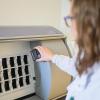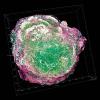Senior Biomedical Scientist Olivia Geling discusses a consent training day she attended and outlines the key messages.

Consent under the Human Tissue Act relates to the purposes for which material might be removed, stored or used. In broad terms, the Human Tissue Act and the Human Tissue Authority’s (HTA) codes of practice require that consent is needed to:
- Store and use dead bodies
- Remove, store and use relevant material from a dead body
- Store and use relevant material from the living.
The training day I attended started with a lecture covering the updated HTA Codes of Practice and Standards, focusing on Code A surrounding consent.
As a biomedical scientist involved in the cut-up area, it was a chance to revisit the fundamentals of the HTA codes and familiarise myself with recent changes to the codes and standards.
The second lecture dealt with facilitating the taking of consent. It described how to effectively take consent, ensuring that full information is imparted to help the family of the deceased make the right decision with regard to giving consent and tissue retention. There were interesting questions that were raised after each lecture that tested the way we respond to scenarios, such as retaining tissues while awaiting further tests and other difficult consent issues.
From a biomedical scientist standpoint, the lectures allowed me to think of how a good consenting process and fully-informed consent can help prevent future problems involving tissue retention and disposal. They highlighted the value of keeping a good record and having a robust system of documentation from tissue removal to disposal. Traceability is the key.
The take-home message for me was to examine closely our departmental policies, documentation system, SOPs and the training of staff members who deal with post-mortem materials and pregnancy remains.
In the afternoon, the participants were divided into smaller groups and given scenarios to discuss. An HTA Regulation Manager was with each group. The scenarios were excellent examples as they were drawn from experiences of some facilities.
The varied backgrounds and expertise of those in the group, the APTs, pathologists, tissue coordinators, biomedical scientists and bereavement officers, contributed to the richness of the discussions. Consent issues that I have encountered in the past, such as delays in decision making regarding disposal wishes, extended retention of materials and issues with returning tissue samples to the family have been somehow clarified in the workshop scenarios. The workshop also stressed the importance of honesty, openness and transparency throughout the consenting and examination process, especially when issues and incidents arise.
The course is a good learning experience for biomedical scientists involved in the running of the cut-up or dissection area, as well as for technical staff dealing with the HTA side who liaise with the coroners, the mortuary staff and the pathologists.
By the end of the training day, participants:
- have knowledge of the HTA Codes for Consent
- have knowledge of the post-mortem consent process
- have practical experience of dealing with consent issues
- are able to facilitate the consent process with NOK and clinician
- are able to inform their trust of consent procedures and best practice
- are able to help set up a consent process.
Olivia Geling is a Senior Biomedical Scientist at Royal Surrey County Hospital




